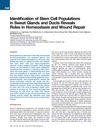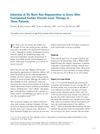TLDR Microcolumn grafting can effectively regenerate full-thickness, functional skin without scarring.
The study explored an innovative method for skin tissue engineering by using microcolumn grafting to reconstitute full-thickness skin. Researchers harvested and implanted micrometer-scale columns of human skin tissue, which were then used to treat wounds in immunodeficient mice. This approach successfully restored key features of normal human skin, such as epidermal architecture, diverse cell populations, and functional sweat glands, without causing scarring or significant morbidity at the donor site. These findings indicated that microcolumn grafting could potentially be a viable technique for regenerating fully functional skin in human wounds.
1235 citations
,
December 2013 in “Nature” Two fibroblast types shape skin structure and repair differently.
20 citations
,
January 2013 in “Plastic & Reconstructive Surgery” The new device safely and effectively rejuvenates skin, making it thicker and healthier.
 265 citations
,
July 2012 in “Cell”
265 citations
,
July 2012 in “Cell” The study found that sweat glands contain different types of stem cells that help with healing and maintaining healthy skin.
 20 citations
,
April 2011 in “Dermatologic Surgery”
20 citations
,
April 2011 in “Dermatologic Surgery” Laser therapy helped new hair grow in scarred skin for three patients.
 829 citations
,
May 2007 in “Nature”
829 citations
,
May 2007 in “Nature” Hair follicles can regrow in wounded adult mouse skin using a process like embryo development.
 14 citations
,
January 2021 in “Scientific Reports”
14 citations
,
January 2021 in “Scientific Reports” Using micro skin tissue columns improves skin wound healing and reduces scarring.
 79 citations
,
October 2015 in “Journal of Dermatological Treatment”
79 citations
,
October 2015 in “Journal of Dermatological Treatment” Platelet-rich plasma may have some benefits in dermatology, but there's not enough evidence to widely recommend its use.
 193 citations
,
February 2015 in “Nature Communications”
193 citations
,
February 2015 in “Nature Communications” Fungi-produced compounds can change plant root growth.
 96 citations
,
September 2017 in “Analytica Chimica Acta”
96 citations
,
September 2017 in “Analytica Chimica Acta” Hair elemental analysis could be useful for health and exposure assessment but requires more standardization and research.
 73 citations
,
January 1994 in “European Urology”
73 citations
,
January 1994 in “European Urology” Finasteride works better than Permixon in reducing dihydrotestosterone levels.







